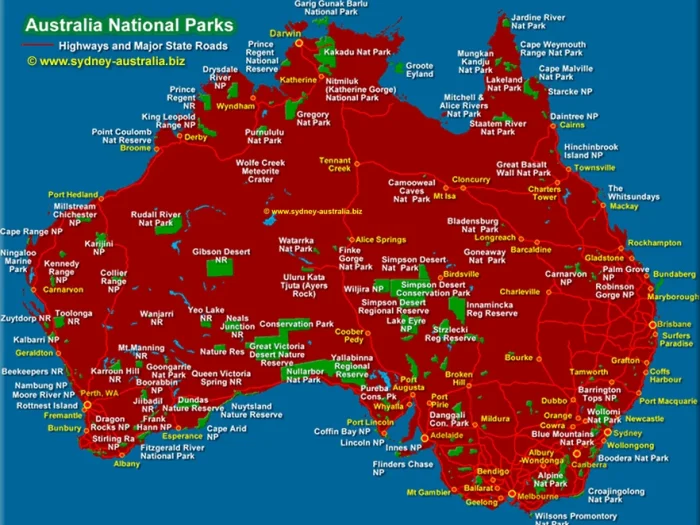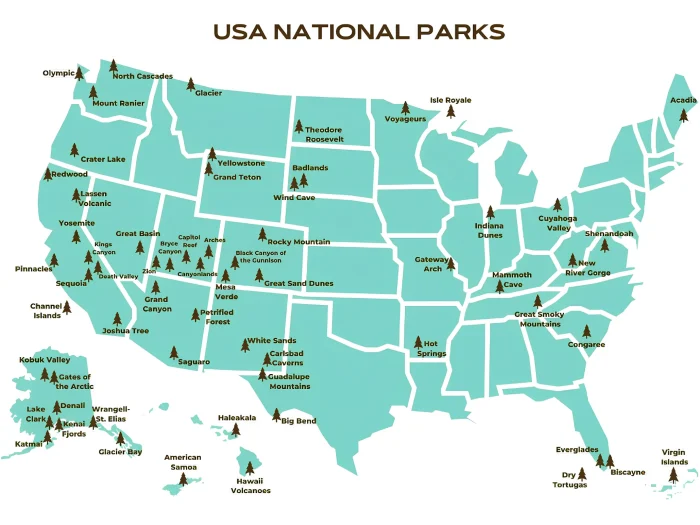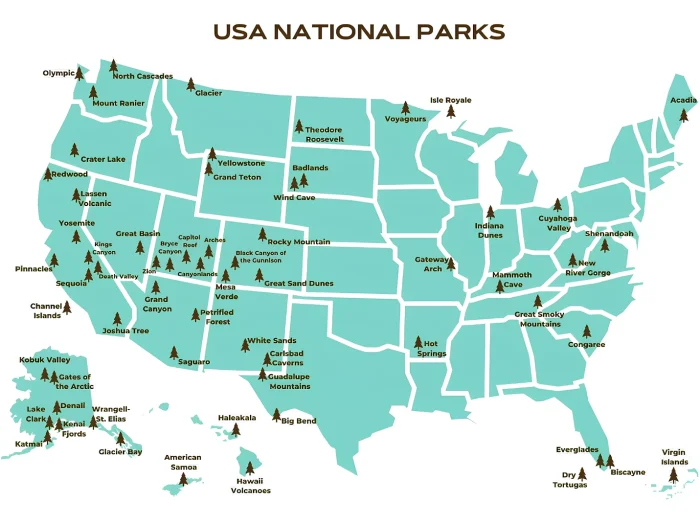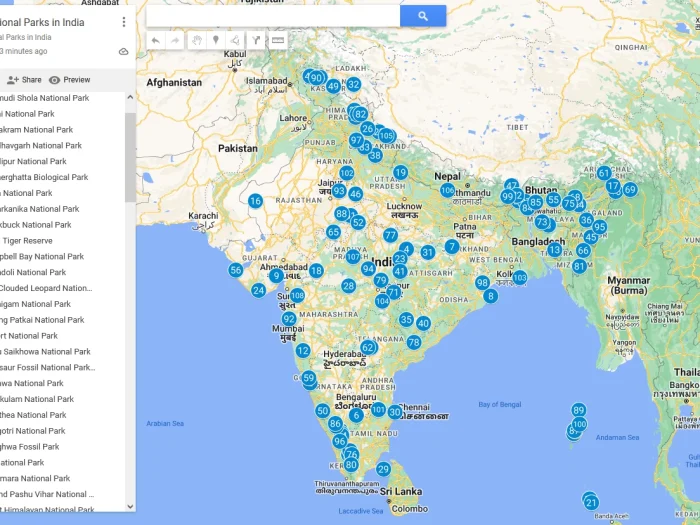List of National Parks in Florida
Florida has 11 national parks:
- Everglades National Park
- Biscayne National Park
- Dry Tortugas National Park
- Big Cypress National Preserve
- Canaveral National Seashore
- Castillo de San Marcos National Monument
- De Soto National Memorial
- Fort Caroline National Memorial
- Fort Matanzas National Monument
- Gulf Islands National Seashore
- Timucuan Ecological & Historic Preserve
In this article I will write about these national parks (address, official website, phone number). I also add Florida National Parks Map at the end of the article.
List of National Parks in Florida
(You can click the image below to see it in full size)
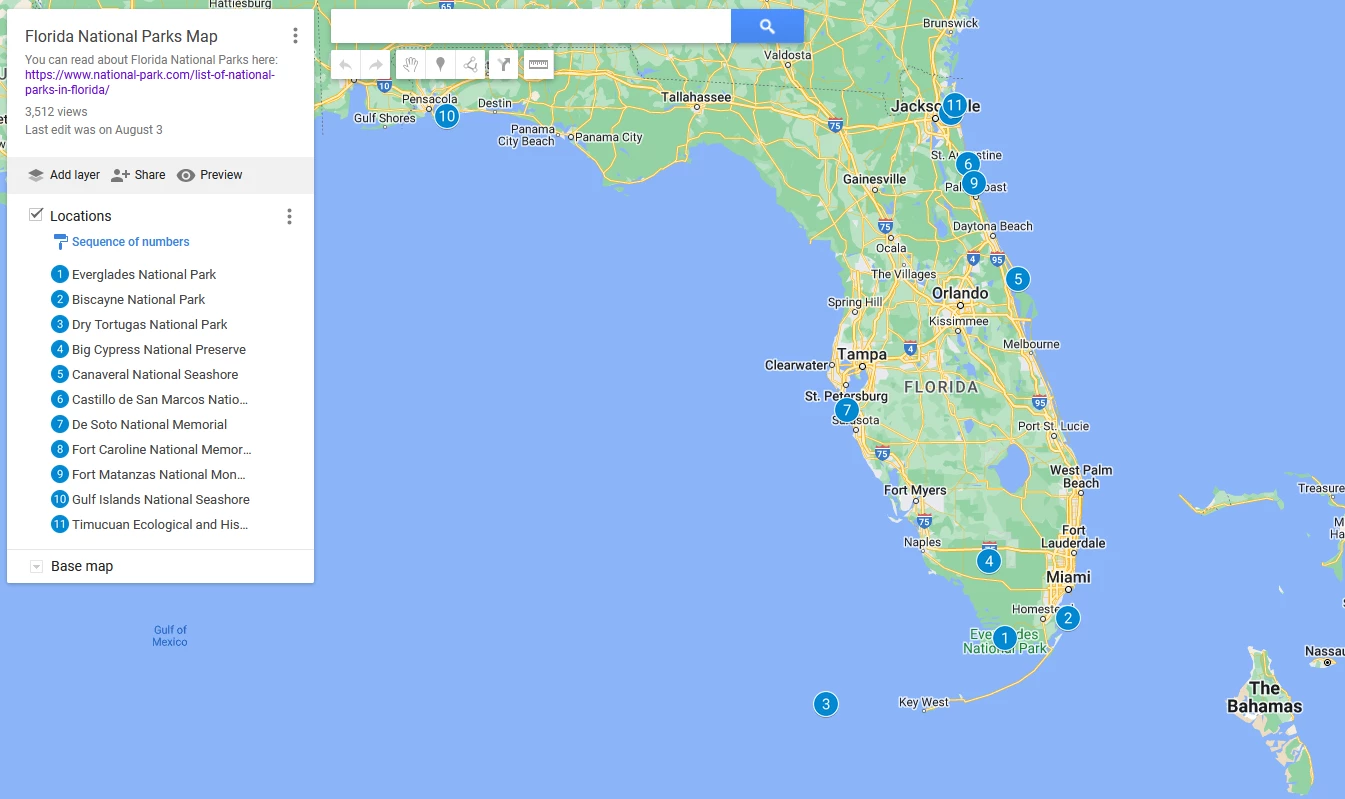
1. Everglades National Park
Everglades National Park, located in southern Florida, is one of the largest subtropical wilderness areas in the United States. It spans over 1.5 million acres and is renowned for its unique ecosystem comprising mangroves, sawgrass marshes, and sloughs. This vast and dynamic environment supports a wide range of wildlife, including the endangered American alligator, the elusive Florida panther, and a plethora of bird species such as the roseate spoonbill and the wood stork. The park is a UNESCO World Heritage site and a Wetland of International Importance, drawing visitors who are eager to explore its waterways by airboat, kayak, or canoe. Hiking and birdwatching are also popular activities.
Contact Details
- Address: Florida, United States
- Offical website: https://www.nps.gov/ever/index.htm
- Phone: +1 305-242-7700
2. Biscayne National Park
Biscayne National Park is located near Miami, Florida, and covers 172,000 acres, of which 95% is water. The park includes Biscayne Bay, its offshore barrier reefs, and over 40 small islands known as keys. It is a marine paradise, featuring vibrant coral reefs, seagrass beds, and mangrove forests. Biscayne National Park is a haven for snorkelers and scuba divers, who come to explore the underwater world teeming with marine life, including colorful fish, sea turtles, and manatees. Boating, fishing, and paddling are also popular activities. The park is dedicated to preserving both its natural and cultural resources, with archaeological sites dating back to prehistoric times and shipwrecks from more recent history.
Contact Details
- Address: Florida, United States
- Offical website: https://www.nps.gov/bisc/index.htm
- Phone: +1 305-230-1144
3. Dry Tortugas National Park
Dry Tortugas National Park is situated approximately 70 miles west of Key West, Florida. The park is composed of seven small islands, coral reefs, and surrounding waters. One of its most notable features is Fort Jefferson, a massive 19th-century coastal fortress that played a crucial role during the Civil War. The clear, turquoise waters of Dry Tortugas are ideal for snorkeling and diving, offering visibility up to 100 feet and abundant marine life, including tropical fish, corals, and shipwrecks. The park is also a significant birdwatching site, especially during the spring migration when thousands of birds pass through. Access to the park is limited to boat or seaplane, making it a remote and pristine destination.
Contact Details
- Address: Florida, United States
- Offical website: https://www.nps.gov/drto/index.htm
- Phone: +1 305-242-7700
4. Big Cypress National Preserve
Big Cypress National Preserve, located in southern Florida, covers more than 720,000 acres and is adjacent to Everglades National Park. It is a diverse and critical watershed that supports the health of the Everglades. The preserve is characterized by vast swamplands, cypress forests, and prairies. It provides habitat for a variety of wildlife, including the endangered Florida panther, black bears, white-tailed deer, and numerous bird species. Visitors can explore the preserve through a network of trails, scenic drives, and waterways. Activities include hiking, birdwatching, wildlife viewing, and swamp buggy tours. The preserve also offers opportunities for camping, hunting, and fishing, providing a unique and immersive outdoor experience.
Contact Details
- Address: 33100 Tamiami Trail E, Ochopee, FL 34141, United States
- Offical website: http://www.nps.gov/bicy
- Phone: +1 239-695-2000
5. Canaveral National Seashore
Canaveral National Seashore, situated on the east coast of Florida, spans 24 miles of pristine barrier island beaches, dunes, and lagoons. It is one of the longest stretches of undeveloped coastline on Florida’s Atlantic coast. The seashore is a sanctuary for wildlife, including sea turtles that nest on its beaches and a variety of bird species. It is also home to the Apollo and Shuttle launch pads at Kennedy Space Center, adding a historical and technological significance to the area. Visitors can enjoy swimming, sunbathing, and beachcombing on its unspoiled beaches. Kayaking, canoeing, and fishing in the Indian River Lagoon offer a different perspective of the park’s natural beauty. The seashore also contains historic sites, including Native American shell mounds and early settler homesteads.
Contact Details
- Address: S Washington Ave, Titusville, FL 32796, United States
- Offical website: http://www.nps.gov/CANA
- Phone: +1 321-267-1110
6. Castillo de San Marcos National Monument
Castillo de San Marcos National Monument is located in St. Augustine, Florida, and is the oldest masonry fort in the continental United States. Constructed by the Spanish in the late 17th century, the fort was built to defend Florida and the Atlantic trade route. Its unique design and coquina (a type of limestone) construction have withstood numerous sieges and battles. Today, visitors can explore the well-preserved fort, walk along its ramparts, and learn about its history through interactive exhibits and reenactments. The fort offers stunning views of the Matanzas Bay and the historic city of St. Augustine, making it a popular destination for history enthusiasts and tourists alike.
Contact Details
- Address: 11 S Castillo Dr, St. Augustine, FL 32084, United States
- Offical website: https://www.nps.gov/casa/index.htm
- Phone: +1 904-829-6506
7. De Soto National Memorial
De Soto National Memorial, located in Bradenton, Florida, commemorates the 1539 landing of Spanish explorer Hernando de Soto and his expedition into the southeastern United States. The memorial is situated at the mouth of the Manatee River, where de Soto and his men began their journey in search of riches and glory. The site features a visitor center with exhibits on the expedition, a reconstructed 16th-century campsite, and living history demonstrations. Visitors can explore nature trails, kayak along the river, and participate in ranger-led programs that provide insights into the history and impact of de Soto’s journey on the Native American populations and the region.
Contact Details
- Address: 8300 Desoto Memorial Hwy, Bradenton, FL 34209, United States
- Offical website: https://www.nps.gov/deso/index.htm
- Phone: +1 941-792-0458
8. Fort Caroline National Memorial
Fort Caroline National Memorial, located near Jacksonville, Florida, preserves the history of a short-lived French colony established in the 16th century. The fort was built by French Huguenots in 1564 as a refuge from religious persecution. It was later captured by the Spanish, who established St. Augustine, the oldest continuously inhabited European settlement in the United States. The memorial includes a reconstructed fort, interpretive exhibits, and walking trails. Visitors can learn about the interactions between the French settlers and the Timucua people, the native inhabitants of the region, and the broader context of European colonization in North America.
Contact Details
- Address: 12713 Fort Caroline Rd, Jacksonville, FL 32225, United States
- Offical website: https://www.nps.gov/timu/learn/historyculture/foca.htm
- Phone: +1 904-641-7155
9. Fort Matanzas National Monument
Fort Matanzas National Monument, located near St. Augustine, Florida, protects a historic Spanish fort built in 1742. The fort was constructed to guard the southern approach to St. Augustine and played a key role in the defense of the Spanish colony. Accessible only by boat, the fort offers guided tours that provide insights into colonial military life and the strategic importance of the area. The monument also features nature trails through coastal marshes and maritime forests, offering opportunities for birdwatching and wildlife viewing. Fort Matanzas is a serene and educational destination that highlights the historical and natural significance of the region.
Contact Details
- Address: 8635 A1A S, St. Augustine, FL 32080, United States
- Offical website: http://www.nps.gov/foma/index.htm
- Phone: +1 904-471-0116
10. Gulf Islands National Seashore
Gulf Islands National Seashore extends across the coastal regions of Florida and Mississippi, protecting some of the nation’s most pristine and scenic beaches. The seashore includes barrier islands, historic forts, and diverse ecosystems ranging from salt marshes to maritime forests. Visitors can enjoy a wide range of recreational activities, including swimming, snorkeling, kayaking, and camping. The seashore is also rich in history, with sites such as Fort Pickens, Fort Barrancas, and the Naval Live Oaks Reservation, which played important roles in American military history. Gulf Islands National Seashore is a popular destination for nature lovers and history buffs alike.
Contact Details
- Address: 2541–2589 J Earle Bowden Way, Gulf Breeze, FL 32561, United States
- Offical website:
- Phone:
11. Timucuan Ecological & Historic Preserve
Timucuan Ecological & Historic Preserve, located in Jacksonville, Florida, encompasses over 46,000 acres of wetlands, waterways, and historic sites. The preserve highlights the natural beauty and cultural heritage of the region, named after the Timucua people who inhabited the area for thousands of years. Key attractions include Fort Caroline National Memorial, Kingsley Plantation, and the Ribault Club. Visitors can explore the preserve through hiking trails, kayaking routes, and guided tours that provide insights into the region’s rich history and biodiversity. The preserve is a sanctuary for wildlife, including manatees, dolphins, and a variety of bird species, making it a prime destination for outdoor enthusiasts and history lovers.
Contact Details
- Address: 12713 Ft Caroline Rd, Jacksonville, FL 32225, United States
- Offical website: https://www.nps.gov/timu/index.htm
- Phone: +1 904-641-7155
Florida National Parks Map
Frequently Asked Questions
1. How many national parks in Florida?
Florida has 11 national parks.
2. What is the best time to visit Everglades National Park?
The best time to visit Everglades National Park is during the dry season, which runs from November to April. The weather is more pleasant, and wildlife viewing is better as animals gather around water sources.
3. How do you get to Dry Tortugas National Park?
Dry Tortugas National Park is only accessible by boat or seaplane from Key West. The ferry ride takes about 2.5 hours one way, and the seaplane flight takes about 40 minutes.
4. Is Biscayne National Park free?
Entry to Biscayne National Park is free, but some activities like snorkeling tours, boat rentals, or guided tours may have fees.
5. Can you camp in Everglades National Park?
Yes, you can camp in Everglades National Park. There are two main campgrounds accessible by car: Long Pine Key Campground and Flamingo Campground. Backcountry camping is also available for more adventurous visitors, but permits are required.
6. What wildlife can you see in Florida’s national parks?
Florida’s national parks are home to diverse wildlife, including:
- Alligators and crocodiles in the Everglades
- Manatees in Biscayne National Park
- Sea turtles along the coastlines of Canaveral National Seashore
- A wide variety of bird species, especially during migration seasons
7. Are pets allowed in Florida national parks?
Pets are generally allowed in some areas of Florida’s national parks, but there are restrictions. For example:
- In Everglades National Park, pets are allowed in parking lots and campgrounds but not on trails or boats.
- Biscayne National Park does not allow pets on the islands or in the water, except for service animals. Always check each park’s specific regulations regarding pets.
8. Can you swim in Biscayne National Park?
Yes, you can swim in Biscayne National Park, especially around the islands and coral reefs. Popular swimming and snorkeling spots include Elliott Key and Boca Chita Key.
9. What is unique about Dry Tortugas National Park?
Dry Tortugas National Park is unique for its remote location, pristine coral reefs, and Fort Jefferson, a massive 19th-century coastal fortress. The park is also known for its vibrant marine life, making it a top spot for snorkeling and scuba diving.
10. What is Florida’s largest National Park?
Florida’s largest national park is Everglades National Park. Covering over 1.5 million acres, it is renowned for its unique ecosystem.
11. What is the smallest national park in Florida?
The smallest national park in Florida is Biscayne National Park. It encompasses approximately 172,971 acres, most of which is water.
12. What are the most popular national parks in Florida?
The most popular national parks in Florida include:
- Everglades National Park – Famous for its wetlands, wildlife (like alligators), and airboat tours.
- Biscayne National Park – Known for its marine life, coral reefs, and opportunities for boating and snorkeling.
- Dry Tortugas National Park – Located 70 miles west of Key West, it features historic Fort Jefferson and excellent snorkeling spots.
- Canaveral National Seashore – Offers pristine beaches, coastal dunes, and diverse wildlife.
Tag: List of National Parks in Florida, list of all national parks in florida, national parks in florida map, map of florida national parks, federal parks in florida
Read more:

